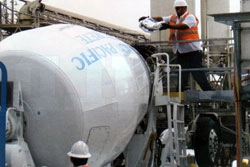Defining PRAH and PRAN with ACI 2.12
- Eben
- May 23, 2022
- 2 min read
Updated: Jan 9

Construction is an incredibly, collaborative process. Although projects may differ in size and scope, there is always a unique group of parties involved.
In the concrete waterproofing industry specifically, communication challenges have been further exasperated as there is often a huge void in standardized terminology which often contributes to the breakdown of communication. This affect has been seen in the concrete waterproofing sector specifically as terms such as “waterproof” and “dampproof” were used devoid of education and clarification.
Fortunately the terminology has recently been defined regarding concrete waterproofing. In fact, The American Concrete Institute’s 212.3R-10 Report on Chemical Admixture document devoted Chapter 15 to Permeability Reducing Admixtures that outlines PRAH and PRAN classifications. Permeability Reducing Admixture — Hydrostatic Conditions or PRAH products reduce water penetration through crystalline growth or a polymer plug can perform under hydrostatic pressure and are suitable for watertight construction.
Conversely dampproofing admixtures are now referred to as Permeability Reducing Admixture — Non-Hydrostatic Conditions or PRAN. PRAN admixtures reduce water absorption by repellent chemicals (soap, oils) or partial pore blocking (line particle Hllers). These admixtures are not suitable for concrete exposed to water under pressure and cannot nrntect in the presence of hydrostatic pressure. Waterproofing against hydrostatic pressure is an important distinction that sets PRAHs”apart from PRANs.
The Kryton International Inc. team plays an active role in the concrete waterproofing industry Many of our employees are members of local and national concrete organizations such as the American Concrete Institute (ACI), working collaboratively towards improving the standards for design, construction, maintenance and repair of concrete structures.
Kryton’s Krystol Internal Membrane or KIM is an integral crystalline concrete waterproofing admixture; and a PRAH. When combined with water, KIM’s proprietary chemicals react to form millions of needle-like crystals. These crystals grow and fill the capillary pores and micro-cracks in the concrete, blocking the flow of water. As time passes and stresses form new cracks, any incoming moisture causes the crystals to reactivate — ensuring continuous waterproofing over the years.

The differentiation outlined between PRAN and PRAH’s only touches the surface of what the new chapter offers the industry With new definitions, testing parameters, selection and evaluation guidelines, ACI’s 212.3R-10 document is a valuable resource to all, especially to those who would not be naturally well-versed in concrete waterproofing. Ultimately the document’s objective is to educate stakeholders so that they are empowered to actively contribute to the construction process; be it specifiers, owners, or applicators. On a higher level, ACI’s 212.3R-10 document is representative of what an industry can achieve when an issue is identified and a collaborative solution is developed to overcome these challenges. These documents not only ensure that the parties are educated, but through specification also ensure that the right products would be used.
Recent Posts
See AllTable Of Content The Hidden Dangers of Rainwater Damage Common Waterproofing Mistakes in Lagos How to Stay Dry This Rainy Season Don’t...





























Comments